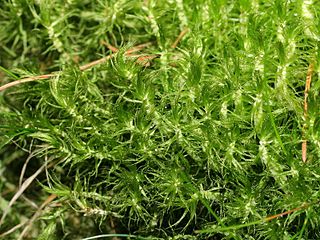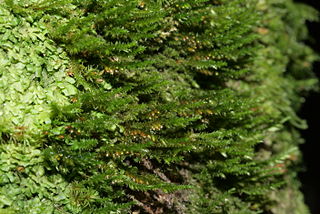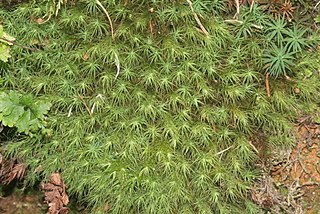
Dicranum is a genus of mosses, also called wind-blown mosses or fork mosses. These mosses form in densely packed clumps. Stems may fork, but do not branch. In general, upright stems will be single but packed together. Dicranum is distributed globally. In North America these are commonly found in Jack pine or Red pine stands.

Gymnostomum is a genus of bryophyte in family Pottiaceae. It was first described by Christian Gottfried Daniel Nees von Esenbeck and Christian Friedrich Hornschuch

Hypnaceae is a large family of moss with broad worldwide occurrence in the class Bryopsida, subclass Bryidae and order Hypnales. Genera include Hypnum, Phyllodon, and Taxiphyllum.

Dicranaceae is a family of haplolepideous mosses (Dicranidae) in class Bryopsida. Species within this family are dioicous. Genera in this family include Dicranum, Dicranoloma, and Mitrobryum.

Grimmia is a genus of mosses (Bryophyta), originally named by Jakob Friedrich Ehrhart in honour of Johann Friedrich Carl Grimm, a physician and botanist from Gotha, Germany.

Cryphaea is a genus of mosses, (Bryophyta), containing at least 26 accepted species.

Tortula is a genus of mosses in the family Pottiaceae.

Bartramiales is an order of moss.

Aulacomnium is a genus of mosses of the family Aulacomniaceae, with a circumpolar distribution.

Plagiomnium is a genus of mosses in the family Mniaceae. It was formerly a part of a more encompassing genus Mnium and in 1968 Finish bryologist Timo Juhani Koponen justified splitting the genus into a number of smaller genera.
Amblyodon dealbatus, short-tooth hump-moss, is a species of mosses belonging to the family Meesiaceae.

Neckera is a large genus of mosses belonging to the family Neckeraceae. The genus was first described by Johann Hedwig. The genus has a cosmopolitan distribution.

Rhynchostegium is a genus of pleurocarpous mosses belonging to the family Brachytheciaceae. The genus has a cosmopolitan distribution across different climatological regions except the polar regions, mostly in tropic to north temperate regions. The genus contains both aquatic and terrestrial species. The genus was named for their rostrate opercula. The type species of this genus is Rhynchostegium confertum (Dicks.) Schimp.

Tetraplodon is a genus of mosses belonging to the family Splachnaceae.

Rhodobryum is a genus of mosses belonging to the family Bryaceae.
Pylaisia is a genus of mosses belonging to the family Pylaisiaceae.

Ptychostomum is a genus of mosses belonging to the family Bryaceae. It has an almost cosmopolitan distribution.
Platygyrium is a genus of mosses belonging to the family Hypnaceae.
Orthothecium is a genus of mosses belonging to the family Hypnaceae.















